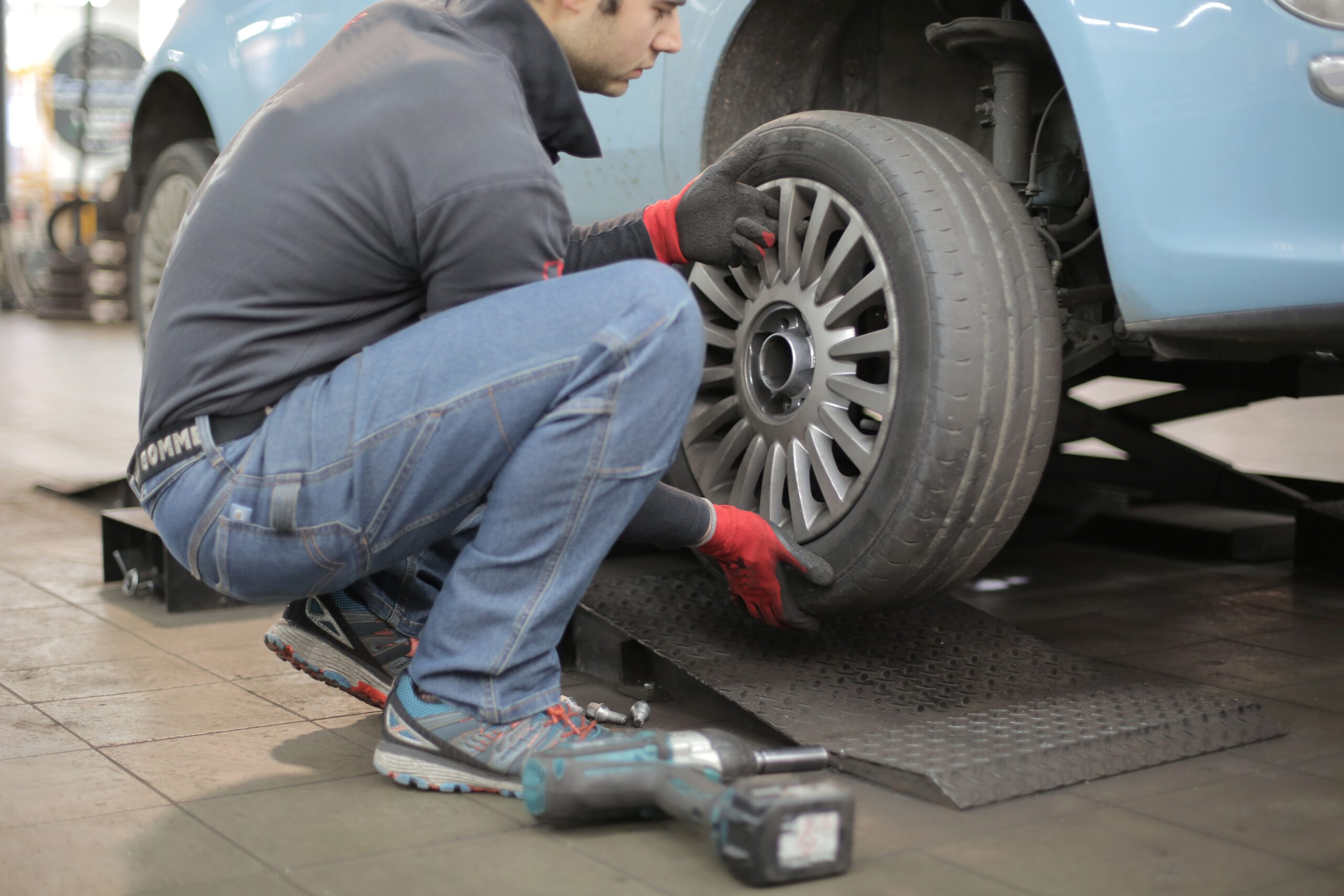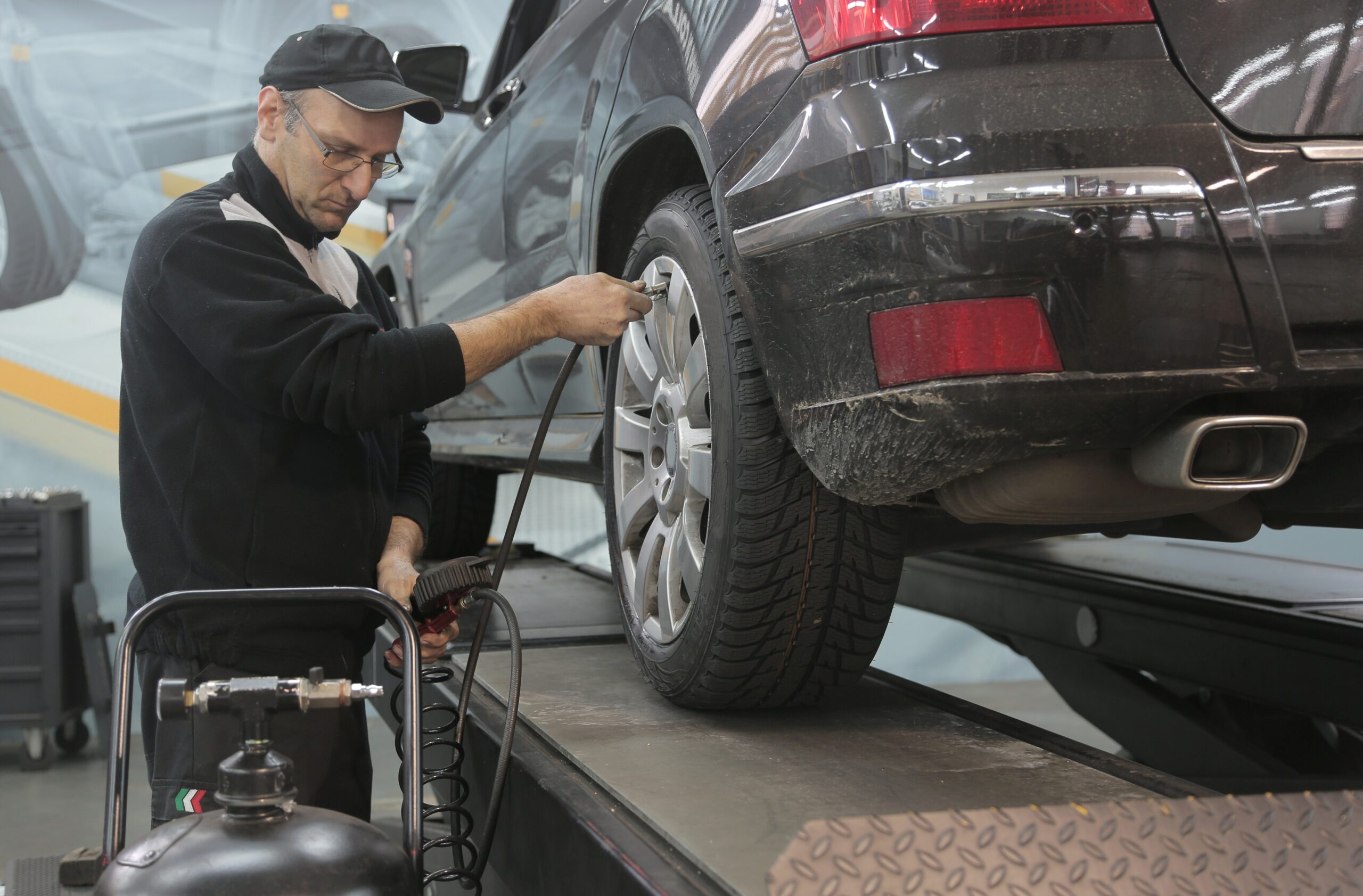Most of us enjoy driving, but in order to do so, you must keep your vehicle in good condition. Understanding how to operate a tire pressure gauge is important for maintaining tires and, by implication, cars. Overinflated tires degrade faster than underinflated tires. Furthermore, they make it harder to stop and manage the car in slick circumstances.
It is vital for good car maintenance to ensure that your tires are neither under- or over-inflated, and understanding how to use a tire pressure gauge properly is a simple way to ensure that your tires and vehicle perform as intended.
Understanding Tire Pressure
Maintaining adequate tire pressure ensures that your tires will last longer. In contrast, poor tire inflation can produce rapid or irregular wear, which can cause considerable internal tire damage, as well as unexpected tire failure and serious injury.
At least once a month, you should check the air in your tires. Tires lose about 1 pound per square inch (PSI) of pressure every month, so this should be part of your weekly care. PSI stands for the least amount of air pressure your vehicle needs to hold up when it’s carrying its full load.
A. The Recommended Tire Pressure
The required tire pressure for an automobile varies according to the make and model, as well as the type of tire used. The recommended tire pressure is normally found on a label on the driver’s side door jamb or in the owner’s handbook.
The recommended tire pressure for cars is usually between 30 and 35 PSI (pounds per square inch). Some vehicles, however, may have a different suggested pressure, so verify the exact requirements for your vehicle.
Checking tire pressure when the tires are cold is important because heat is made when the tires rub against the road. This raises both the temperature and the air pressure.
Do not fill your tires to the pressure suggested on the tire. That figure represents the maximum pressure that the tire can withstand, not the recommended pressure for the vehicle.
Overinflation of your tires can result in a bouncy ride and an unresponsive vehicle, whilst driving on underinflated tires will result in premature tire wear due to higher friction. In any case, failing to keep your tires inflated to the proper pressure will have a detrimental impact on tire wear and vehicle performance, as well as your maintenance schedule when it comes to replacing them.
B. Factors That Affect Tire Pressure
1. Temperature
Temperature has an effect on tire pressure parameters because air expands when heated and contracts when cooled. This means that as the temperature rises, the air inside a tire expands, causing tire pressure to rise. Similarly, as the temperature drops, the air within a tire contracts, lowering tire pressure.
For example, if a tire is properly filled on a hot summer day, the tire pressure may be higher than the recommended pressure on a cold winter day. This is because the air inside the tire expanded owing to the greater temperature on the hot day, and then contracted when the temperature dropped on the cold day.
It’s critical to check tire pressure on a regular basis and adjust as needed, especially during extreme temperature changes. This can assist maintain adequate inflation and safe driving, since underinflated or overinflated tires can cause uneven wear, limit traction, and increase the danger of an accident.
2. Altitude
The height above sea level or the Earth’s surface is referred to as altitude. Because there is less atmospheric pressure bearing down on the Earth’s surface as height climbs, air pressure falls. This means that at greater elevations, the air pressure inside a tire will likewise decrease.
When traveling at high altitudes, it is critical to check tire pressure more regularly, as a drop in air pressure can cause tires to become underinflated. Underinflated tires can impair fuel efficiency, cause poor handling, and raise the chance of a blowout.
Furthermore, some cars may be equipped with altitude-compensating tire pressure monitoring devices that compensate for changes in air pressure at higher altitudes. However, checking tire pressure on a regular basis is still necessary to maintain adequate inflation and safe driving.
3. Type of Tire
Due to differences in load capacity, construction, and performance, the suggested tire pressure can change depending on the type of tire.
For example, a high-performance tire made for a sports car might need a higher tire pressure than a normal passenger tire to handle the high speeds and cornering forces that come with sporty driving. On the other hand, a heavy-duty truck tire made for towing or hauling may need a higher tire pressure to handle the added weight and load capacity.
In general, different types of tires can carry different amounts of weight and need different levels of air pressure to support the vehicle’s weight and work best. If you overinflate or underinflate a tire, it will wear unevenly, lose grip, and make it more likely that you will get into an accident. To make sure you can drive safely, it’s important to choose the right kind of tire and keep the right air pressure in it.
4. Load
The weight that a tire supports is referred to as its load. The amount of weight that a tire can safely bear is governed by its load capacity, which is usually printed on the sidewall of the tire in the form of a load index number.
A tire’s load capacity is impacted by various factors, including its size, construction, and type. Because different types of tires have varied load capacities, it is critical to select the correct type of tire for the vehicle and driving conditions.
The amount of air in a tire also influences its load capability. Underinflated tires cannot sustain as much weight as properly inflation tires, causing the tire to wear out faster and increasing the danger of an accident. Overinflated tires can handle greater weight, but they can also create uneven wear and limit traction, increasing the danger of an accident.
To establish the correct inflation pressure for a certain tire and load, consult the vehicle owner’s manual or a tire technician. It is critical to check tire pressure on a regular basis and adjust as needed to guarantee adequate inflation and safe driving, especially while hauling big loads.
5. Driving Habits
Driving behaviors can influence tire pressure in a variety of ways. Hard braking and acceleration, as well as making sharp turns, can place extra strain on the tires, causing them to heat up and potentially lose pressure. Excessive weight on the car can also cause the tires to wear out faster and influence the pressure. Driving on poor or uneven roads, or hitting potholes and debris, can damage the tires or rims, causing pressure to drop. In general, excellent driving behaviors that reduce tire stress can assist maintain correct tire pressure and extend tire life. It is also critical to check tire pressure and execute correct maintenance on a regular basis to maintain safe driving.
6. Maintenance
Maintaining optimum tire pressure requires regular maintenance. Regularly checking tire pressure and inflating or deflating the tires as needed will help guarantee proper inflation, which can contribute to greater fuel efficiency, tire life, and handling. Proper wheel alignment, tire rotation, and tire balancing can also aid in the prevention of uneven tire wear, which can impair tire pressure and handling. Furthermore, regular tire inspections and repairs can assist detect punctures or damage to the tire early on, thereby preventing a blowout.
7. Damage and Leaks
Damage and leaks can have a substantial impact on tire pressure. When a tire is damaged, whether by punctures, fractures, or cuts, air can escape, causing the tire to lose pressure. Even minor leaks might result in steady pressure reduction over time, resulting in underinflation. Underinflated tires can cause the tire to wear out faster, as well as reduced fuel efficiency and handling concerns.
Furthermore, tire damage can weaken the tire’s structure, making it more prone to blowouts or even complete tire failure. This is risky and can lead to major accidents when driving. Tires should be inspected on a regular basis for signs of damage or leakage and fixed or replaced as needed.
C. Consequences of Underinflated and Overinflated Tires
1. Blowout
Blowouts are catastrophic tire failures. When the internal bands fail altogether, the tire bursts. While exceeding the manufacturer’s suggestion may appear to be safe because you are still within the tire’s operating range, it might nevertheless cause problems. This PSI is recommended by the manufacturer to compensate for significant bumps. Heavy hits compress the air in the tire, creating brief increases in PSI. If the tire is too close to its maximum rating, this fast spike can trigger a blowout. Underinflation might also result in a blowout. The sidewall of a tire bulges outward when it is underinflated. This extra flex in the sidewall impairs its ability to bear weight and can result in a sidewall blowout.
2. Fuel Economy
Underinflated tires can have a significant influence on your vehicle’s fuel economy. The greater the rolling resistance of a tire, the lower the tire pressure. The increased rolling resistance compels the engine to work harder to move the car, decreasing fuel economy.
3. Handling
Underinflation can have a significant impact on your vehicle’s handling qualities. Under-inflation allows the sidewall to stretch. This creates a lot of movement of the vehicle relative to the tread and can result in the tread losing contact due to the vehicle’s rapid movement.
4. Tread Wear
Most drivers want to get the most life out of their tires. Over and underinflation can substantially reduce tire life. Overinflation causes the center area of the tread to bulge outward. This puts greater weight on the tire’s center. Because of the added weight, the tire’s center wears down quickly. Underinflation has the reverse effect of allowing the core to cave inward, pushing the outer edges to bear additional weight. This added weight causes inner and outer edge wear.
5. Comfort
Overinflated tires have an effect on your vehicle’s ride comfort. Overinflated tires are unable to absorb the impact of minor road holes as effectively as properly inflated tires, resulting in a bumpy ride. Because of the thicker sidewall, the tires transmit significantly more road noise into the vehicle’s cabin.
6. Hydroplaning
When the tires’ contact with the road is interrupted by a layer of water, this is referred to as hydroplaning. This results in a brief loss of vehicle control. Underinflation increases the likelihood of hydroplaning by creating a bigger footprint. Because of the bigger footprint, more water can get between the tire and the road, producing hydroplaning.
7. Loss of traction
Traction loss is caused by either under or overinflated tires. When your tires are overinflated, the contact patch shrinks and only the center of the tire makes touch with the road because it bulges out.
Low tire pressure can also cause the sides of the tire to bend, which makes the car hard to control. You may also find that your stopping distance has increased in these situations.
8. Excessive wear on the center treads
Tire tread naturally wears out over time as you drive more and more miles. As this occurs, check to see if the tread is worn more on the outside or interior of the tire surface.
If your tire is overinflated, you will notice that the center treads have worn far faster than the remainder of the tire.
9. Vibrations
You may notice your car vibrating if you have less air in your tires than is required. The steering wheel may even start shaking.
In this instance, your tires have gotten misaligned as a result of being underinflated.
10. Uncomfortable to drive
Overinflation, on the other hand, results in an uncomfortable ride and a loss of grip. When this happens, you are more likely to feel every bump that your car goes over because a properly inflated tire is supposed to absorb part of the shock.
Types of Pressure Gauges
A pressure gauge for automobile tires is a device that measures the amount of air in a vehicle’s tires. To ensure that car tires are properly inflated, check the air pressure in them on a regular basis with a pressure gauge. Tires that are overinflated or underinflated can cause control and safety issues as well as uneven tire wear, lowering tire life.
A. Dial Pressure Gauge
A dial gauge, also known as an analog gauge, is a type of instrument that uses a mechanical display to display a measurement, generally with a needle or pointer moving over a scale. Dial gauges are frequently used to measure physical quantities like pressure, temperature, speed, or voltage.
A dial gauge can be used to measure the air pressure within a tire in the context of tire pressure. It often has a round dial with a moving needle that indicates tire pressure. The gauge is put against the tire’s valve stem, and the position of the needle on the dial indicates the reading. Dial gauges are frequently portable, simple to use, and inexpensive, although they may be less accurate than other types of gauges.
B. Stick Pressure Gauges
Stick pressure gauges, also known as pencil gauges or pen gauges, are a form of pressure gauge that is small and compact and shaped like a pen or pencil. They are commonly used to test tire pressure and are a handy tool to keep in a glove box or tool pack.
To use a stick gauge, simply remove the cap from the end of the gauge and insert the tip into the valve stem of the tire. A small piston inside the gauge moves in reaction to the air pressure in the tire, and the reading is displayed on a scale printed on the gauge’s side.
Stick gauges are relatively simple to use and can be accurate if correctly calibrated. However, they may be less accurate than digital or dial gauges and can be impacted by temperature changes and other variables. It is critical to ensure that the gauge is properly placed into the valve stem and held straight while taking a reading. Stick gauges, like other gauges, should be calibrated on a regular basis to maintain accurate readings.
C. Digital Pressure Gauges
Digital pressure gauges are pressure gauges that show the pressure reading on a digital screen rather than a dial face and a needle. They’re frequently used to measure tire pressure, as well as pressure in other applications like hydraulic systems, gas cylinders, and air compressors.
To use a digital gauge, simply push the gauge against the tire’s valve stem and wait for the reading to appear on the screen. Digital gauges may have extra features such as the ability to switch between pressure units or save past readings.
Digital gauges are more accurate than dial gauges and are typically easier to read, especially if they have a large, clear display. They are also less susceptible to temperature fluctuations and other environmental variables that might degrade dial gauges. Digital gauges, on the other hand, may be more expensive than dial gauges and may require batteries or other power sources.
Using a Pressure Gauge
A. Step by Step Guide on Using a Pressure Gauge
1. Unscrew the valve cap from the valve stem of the tire you want to check.
2. Insert the nozzle of the gauge onto the valve stem. Make sure the gauge nozzle is firmly seated and not leaking any air.
3. After the gauge is firmly attached, read the gauge display. It will show the current tire pressure.
4. Check the recommended tire pressure for your vehicle. This information can be found on the vehicle owner’s manual, the tire information placard, or the tire itself.
5. Compare the gauge reading to the recommended pressure. If the reading is too high or too low, adjust the pressure accordingly.
6. After taking the reading, remove the gauge from the valve stem.
7. Re-check the tire pressure after adjustment to ensure it is within the recommended range.
8. Once the pressure is set and the gauge is removed, replace the valve cap to prevent debris from entering the valve.
B. Common Mistakes to Avoid While Using a Pressure Gauge
1. Not checking the recommended tire pressure before use.
2. Using an inaccurate gauge.
3. Not holding the gauge straight and perpendicular to the valve stem.
4. Not pressing the gauge firmly onto the valve stem to ensure a proper seal.
5. Not releasing air from the tire before taking a pressure reading when the tire is over-inflated.
6. Neglecting to check all four tires, including the spare tire.
7. Not replacing the valve cap after checking and adjusting the tire pressure.
C. Importance of Using a Reliable Pressure Gauge
Using a reliable pressure gauge ensures that you get accurate readings of your tire pressure, which is critical for safe driving, fuel efficiency, and tire life. A faulty pressure gauge may produce erroneous readings, leading in underinflated or overinflated tires, poor handling, lower grip, decreased fuel efficiency, and uneven tire wear. Using a reliable pressure gauge, you can guarantee that your tires are inflated to the proper pressure, which can help prevent accidents, extend tire life, and save you money on gasoline and tire repairs in the long run.
Conclusion
Understanding how to operate a pressure gauge for car tires is a crucial skill for any driver. Maintaining optimum tire pressure can enhance safety, fuel efficiency, tire wear, and ultimately save you money in the long term. There are various types of pressure gauges available, including dial, digital, and stick gauges. It is critical to select a dependable gauge and avoid common mistakes such as choosing the incorrect gauge or failing to check the gauge’s accuracy. By following the simple steps provided in this tutorial, you can guarantee that your tires are correctly inflated, extend the life of your tires, and drive safely on the road.




